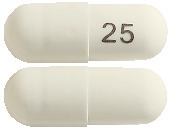Notes
Distributed by Generic Health Pty Ltd
Boxed Warnings
Misuse, abuse potential or dependence. Pregabalin Lupin is a potential drug of misuse, abuse, and dependence. Pregabalin Lupin poses risks of misuse, abuse and dependence which can lead to overdose and death especially when used concomitantly with opioids and other CNS depressants. Assess the patient's risk of misuse, abuse or dependence before prescribing and monitor the patient regularly during treatment, particularly amongst patients with current or past misuse, abuse or dependence of opioids and/or benzodiazepines (see Section 4.4 Special Warnings and Precautions for Use).
1 Name of Medicine
Pregabalin.
2 Qualitative and Quantitative Composition
Pregabalin Lupin capsules contain 25, 50, 75, 100, 150, 200, 225 or 300 mg of the active ingredient pregabalin.
Excipients with known effect. Sugars as lactose (25 and 50 mg strengths);
lactose (all other strengths).
For the full list of excipients, see Section 6.1 List of Excipients.
3 Pharmaceutical Form
Pregabalin Lupin 25 mg capsules. Size: 4 hard gelatin capsule, cap: light grey, body: light grey with "25" printed in black ink.
Pregabalin Lupin 50 mg capsules*. Size: 3 hard gelatin capsule, cap: light grey, body: light grey with "50" and a black line printed in black ink.
Pregabalin Lupin 75 mg capsules. Size: 4 hard gelatin capsule, cap: caramel, body: light grey with "75" printed in black ink.
Pregabalin Lupin 100 mg capsules*. Size: 3 hard gelatin capsule, cap: red, body: red with "100" printed in black ink.
Pregabalin Lupin 150 mg capsules. Size: 2 hard gelatin capsule, cap: light grey, body: light grey with "150" printed in black ink.
Pregabalin Lupin 200 mg capsules*. Size: 1 hard gelatin capsule, cap: red, body: red with "200" printed in black ink.
Pregabalin Lupin 225 mg capsules*. Size: 1 hard gelatin capsule, cap: red, body: light grey with "225" printed in black ink.
Pregabalin Lupin 300 mg capsules. Size: 0 hard gelatin capsule, cap: caramel, body: light grey with "300" printed in black ink.
*Non-marketed presentations.
4 Clinical Particulars
4.9 Overdose
Symptoms. In overdoses up to 15 g, no unexpected adverse effects were reported.
In post-marketing experience, the most commonly reported adverse events observed when pregabalin was taken in overdose included affective disorder, somnolence, confusional state, depression, agitation and restlessness. Seizures were also reported.
Management. There is no specific antidote for pregabalin. Treatment of pregabalin overdose should be symptomatic and supportive.
Consider administration of activated charcoal in the event of a potentially toxic ingestion. Activated charcoal is most effective when administered within one hour of ingestion. In patients who are not fully conscious or have impaired gag reflex, consideration should be given to administering activated charcoal via nasogastric tube once the airway is protected.
Haemodialysis may be useful in patients with severe toxicity or those with significant renal impairment (see Section 4.2 Dose and Method of Administration, Use in renal impairment). Standard haemodialysis procedures result in significant clearance of pregabalin (approximately 50% in 4 hours). Emesis is not recommended because of the potential for CNS depression and seizures.
For information on the management of overdose, contact the Poisons Information Centre on 131126 (Australia).
5 Pharmacological Properties
5.3 Preclinical Safety Data
Genotoxicity. Pregabalin is not genotoxic based on results of in vitro and in vivo tests. It was not mutagenic in bacteria or in mammalian cells in vitro, not clastogenic in mammalian systems in vitro and in vivo, and did not induce unscheduled DNA synthesis in mouse or rat hepatocytes.
Carcinogenicity. Two-year carcinogenicity studies with pregabalin were conducted in rats and mice. No increased incidence of tumours was observed in rats at exposures (plasma AUC) up to 25 times the expected human exposure at the maximum recommended clinical dose of 600 mg/day. In mice, no increased incidence of tumours was found at exposures similar to the expected maximum human exposure, but an increased incidence of haemangiosarcoma was observed at exposures 6 to 33 times the expected maximum human exposure. The precise non-genotoxic mechanism of pregabalin-induced tumour formation is not fully characterised. However, available data show that platelet changes associated with the formation of this tumour in mice are not seen in rats, monkeys or humans. Although long-term data in humans are limited, these findings in mice are thought not to pose a risk to humans.
6 Pharmaceutical Particulars
6.7 Physicochemical Properties
Pregabalin is a white to off-white solid. It is sparingly soluble in water and basic and acidic aqueous solutions.
Chemical structure.
https://stagingapi.mims.com/au/public/v2/images/fullchemgif/CSPREGBL.gif Chemical name: (S)-3-(aminomethyl)-5-methylhexanoic acid.
Molecular formula: C8H17NO2.
Molecular weight: 159.23.
CAS number. 148553-50-8.
7 Medicine Schedule (Poisons Standard)
S4 (Prescription Only Medicine).
Summary Table of Changes
https://stagingapi.mims.com/au/public/v2/images/fulltablegif/PRELUPST.gif

